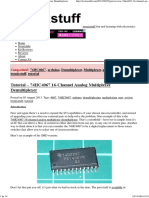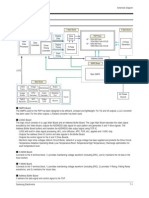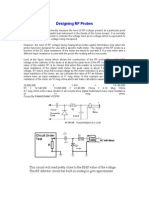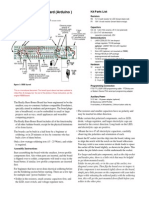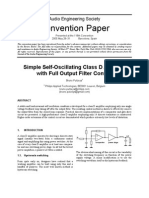Mastering Electronics Design
Mastering Electronics Design
Uploaded by
Arunabh BhattacharyaCopyright:
Available Formats
Mastering Electronics Design
Mastering Electronics Design
Uploaded by
Arunabh BhattacharyaCopyright
Available Formats
Share this document
Did you find this document useful?
Is this content inappropriate?
Copyright:
Available Formats
Mastering Electronics Design
Mastering Electronics Design
Uploaded by
Arunabh BhattacharyaCopyright:
Available Formats
6/23/2016
MasteringElectronicsDesign.com : How to Derive the RMS Value of a Sine Wave with a DC Offset
Mastering Electronics Design
Visit Mastering
Electronics Design
page on Facebook
and on NetworkedBlogs
124 Followers so far
Related Posts
1. How to Derive the RMS Value of Pulse and Square Waveforms
2. How to Derive the RMS Value of a Trapezoidal Waveform Part 1
3. How to Derive the RMS Value of a Triangle Waveform
4. How to Calculate the RMS Value of an Arbitrary Waveform
Books I recommend
Data Conversion
Handbook
Analog Devices Inc...
Privacy Information
M y comment: Great book to learn ADCs and DACs from the people who design them at Analog Devices. It covers the ADCs and DACs
technologies, how to choose them for your design, and explains in detail their specifications.
Click to see another book or
Check the full list here
http://masteringelectronicsdesign.com/how-to-derive-the-rms-value-of-a-sine-wave-with-a-dc-offset/
1/14
6/23/2016
MasteringElectronicsDesign.com : How to Derive the RMS Value of a Sine Wave with a DC Offset
ROHM/
SiC Power
Module
1200V/180Arated SiC MOS
module SW
frequencies
over 50kHz
supported
Useful Electronics Links
SPICE Links
Semiconductor Manufacturers
Electronics Forums
Notable Articles in Electronics Design
Ads by Google
RMS
Sine Wave
Square Root
You may also be interested in
Build an Op Amp SPICE Model from Its Datasheet - Part 3
Design a Differential Amplifier the Easy Way with Mathcad
Why this website?
The RMS Value of a Trapezoidal Waveform Part 2
Build an Op Amp SPICE Model from Its Datasheet - Part 2
Why do I do this?
Using the Summing Amplifier as an Average Amplifier
Bipolar to Unipolar Converters Based on a Summing Amplifier Configuration
http://masteringelectronicsdesign.com/how-to-derive-the-rms-value-of-a-sine-wave-with-a-dc-offset/
2/14
6/23/2016
MasteringElectronicsDesign.com : How to Derive the RMS Value of a Sine Wave with a DC Offset
Sites I follow
EDN Design Ideas
Analog Devices
New Products at Texas Instruments
Linear Technology Corporation
EEWeb
Electronic Products
Ads by Google
True RMS Meter
Derive 5
Offset Offset
How to Derive the RMS Value of a Sine Wave with a DC Offset
by Adrian S. Nastase
45 Comments
Subscribe
I noticed a question posted on one of Yahoos Q&A sites, asking what is the RMS value of a sine wave with a DC offset. The chosen
answer as being the best was actually wrong. The next comment, which was trying to correct the best answer, was wrong too. I am
not going to post the Yahoo link here. What I can do, is to show how to derive the RMS value of such waveform.
Lets derive first the RMS value of a sine wave with no DC offset
Lets start with the RMS value of a sine wave, with no DC offset, which is shown in Figure 1. It is well known that the RMS value of a
sine wave is 0.707 times the signal peak level, but how can you prove this?
Figure 1
As shown in this article, MasteringElectronicsDesign.com: How to Derive the RMS Value of a Trapezoidal Waveform, or other RMS
articles in this website , lets start with the RMS definition.
http://masteringelectronicsdesign.com/how-to-derive-the-rms-value-of-a-sine-wave-with-a-dc-offset/
3/14
6/23/2016
MasteringElectronicsDesign.com : How to Derive the RMS Value of a Sine Wave with a DC Offset
(1)
The sine wave time dependency can be described by the following function:
(2)
T is the function period, or T = 1/f where f is the waveform frequency. Also, a1 is the amplitude.
Replacing (2) in (1), and calculating the integral over a full period T, we find the RMS value squared as in the following equation:
(3)
The standard method to calculate a squared sine integral is to transform it into its double angle equivalent, using a trigonometric identity
usually called the power-reduction formula.
(4)
So the RMS squared becomes
(5)
If youre wandering why the sine term is zero in the previous equation, thats because
(6)
Therefore, the RMS value of a sine wave with offset zero is the following well known formula,
(7)
The RMS Value of a Sine Wave with a DC Offset
http://masteringelectronicsdesign.com/how-to-derive-the-rms-value-of-a-sine-wave-with-a-dc-offset/
4/14
6/23/2016
MasteringElectronicsDesign.com : How to Derive the RMS Value of a Sine Wave with a DC Offset
Figure 2
Now, lets look at a sine wave with a DC offset. This waveform is shown in Figure 2 and is described by the following function.
(8)
where with a0 I noted the DC offset. Applying the RMS definition, the RMS squared can be written as:
(9)
Lets calculate the integral.
(10)
(11)
(12)
(13)
(14)
Therefore, the RMS value of a sine wave with a DC offset is given by the following expression.
(15)
The immediate verification of the validity of this expression is the RMS value of a sine wave with zero DC offset. Indeed, when a0 = 0
V, the RMS level reverts back to equation (7), which is 0.707 of the sine amplitude.
Expression (15) can also be verified by comparing it with Parsevals Theorem. This theorem says that the integral of the square of a
function is equal with the integral of the squared components of its spectrum. In effect, the theorem states that the total energy of a
waveform can be found in the total energy of the waveforms Fourier components. In our case, a0 is the DC level, or the frequency zero
component, and a1 is the fundamental frequency. There are no other Fourier components. As such, the RMS value of a sine wave with
a DC offset as given by expression (15) is correct.
http://masteringelectronicsdesign.com/how-to-derive-the-rms-value-of-a-sine-wave-with-a-dc-offset/
5/14
6/23/2016
MasteringElectronicsDesign.com : How to Derive the RMS Value of a Sine Wave with a DC Offset
Like 86 people like this. Sign Up to see w hat your friends like.
(This article was viewed 105,295 times)
Tags: RMS, waveform
Categories: Analog Design, RMS, Waveforms
My Interview in EEWeb
Open-loop, Closed-loop and Feedback Questions and Answers
45 Comments to How to Derive the RMS Value of a Sine Wave with a DC Offset
1. Brian Coode says:
April 6, 2012 at 1:44 pm
Helped me refresh some theory
Reply
Adrian S. Nastase says:
June 24, 2012 at 6:17 pm
Glad to hear that. Come back soon.
Reply
vishnu says:
June 25, 2015 at 3:18 am
Sine wave having rms value =100v is superimposed with 50 v DC supply ?
Reply
Adrian S. Nastase says:
June 25, 2015 at 6:16 am
You need to reformulate your question. I do not understand what is it that you are asking.
Reply
2. David says:
April 18, 2012 at 11:32 am
So do True RMS multimeters read this value correctly if there is a DC offset on a sine wave or are they really AC coupled
and read the RMS value of the AC component only? If I owned a true RMS meter, I would try it myself but alas, I dont.
Reply
Adrian S. Nastase says:
June 24, 2012 at 6:15 pm
You need to check the datasheet of the multimeter. Not all of them are capable of measuring the RMS value of an AC
signal riding on a DC level. I would not take that for granted, even if it says true RMS measurement. Most manufacturers
will make sure to write this capability in the multimeter feature list.
Reply
3. Tom - houston samsung repair says:
August 2, 2012 at 9:23 pm
I was highly skilled in Math in a previous life. Ever since then, I forgot most of my teachings. After reading this article, my
memory gradually began to be refreshed. Thank you.
http://masteringelectronicsdesign.com/how-to-derive-the-rms-value-of-a-sine-wave-with-a-dc-offset/
6/14
6/23/2016
MasteringElectronicsDesign.com : How to Derive the RMS Value of a Sine Wave with a DC Offset
Reply
4. Theo says:
August 25, 2012 at 7:43 am
Thanks, correct apart from the last line! Either u-squared OR root the RHS!
Reply
Adrian S. Nastase says:
August 25, 2012 at 6:44 pm
Thank you for seeing that typo. I fixed it.
Reply
5. ashish says:
August 25, 2012 at 2:45 pm
infinite thanks sir,specially why the sine term becomes zero,I searched lot on that yours explanation is best.
Reply
6. Javed Bukhari says:
September 13, 2012 at 4:57 pm
RMS really points to the heating enregy present in any waveform. So be it Sine wave or DC voltage riding on it irrespective of
the polority of any component the final effect of all the components is governned by superposition theorm, provided the effective
bandwidth is infinite or close to it.
Reply
7. Jessie M says:
September 20, 2012 at 4:16 am
Excellent article, sir and thank you for this website.
Reply
8. DRB says:
October 3, 2012 at 7:20 pm
For the purposes of an actual answer, doesnt a1 need to be the peak of the non offset sinusoid, not the peak of the shifted
sinusoid(as shown in your figure 2)?
Reply
Adrian S. Nastase says:
October 4, 2012 at 7:25 pm
Yes, that is the case, as figure 1 shows. Ill make sure to make it clearer on figure 2 by adding/subtracting a1 from offset.
Thank you for your comment.
Reply
9. J. Hu says:
November 7, 2012 at 2:14 pm
I just calculate the RMS value using integration method, by hand, immediately after I saw this title and then scroll to the bottom of
your article to check whether Ive a correct answer. But when spectrum power shows, I realize I wasted my time,
Reply
Adrian S. Nastase says:
November 8, 2012 at 6:00 am
Sure, you do not need to start with the integral, unless you want to verify my calculations. It is, indeed, a waste of time.
http://masteringelectronicsdesign.com/how-to-derive-the-rms-value-of-a-sine-wave-with-a-dc-offset/
7/14
6/23/2016
MasteringElectronicsDesign.com : How to Derive the RMS Value of a Sine Wave with a DC Offset
Just apply the formula and youre done.
Reply
10. dox says:
December 18, 2012 at 9:59 pm
Wouldnt it be easier to explain the answer as the square-root of the sum of squares of the RMS components?
RMS of DC = DC or a0
RMS of AC = ACpk/sqrt(2) or a1/sqrt(2)
RMS of combination = sqrt(a0^2 + a1^2/2)
This approach makes more complex functions easier to address. For example, add a triangular wave with amplitude a2 riding on
this offset sine:
RMS of triangle = Peak/sqrt(3)
RMS of combo = sqrt(a0^2 + a1^2/2 + a2^2/3)
Reply
Adrian S. Nastase says:
December 18, 2012 at 10:54 pm
Your comment is correct regarding the calculation of RMS values based on the square root of the sum of squares. I am
not sure that it is simpler though. In any case, this subject is part of a planned article I am writing in this series about RMS
calculation. Not everybody understands the root square of the sum of squares and I plan to explain it in the near future. In
this article I showed the derivation of the RMS value starting from the definition.
Thank you for your input.
Reply
11. Musician says:
January 19, 2013 at 11:02 am
Hey!
I am musician and am interested how a digital DAW would read pure DC offsets RMS and peak dbs. Any ideas on this? I think
a sine with DC offset would end up being louder on the meter and with higher peak.
Reply
Adrian S. Nastase says:
January 20, 2013 at 2:24 am
By DAW you mean a Digital Audio Workstation, right? From my time in the professional audio industry I know that
offsets are dreaded in this business. So, I am not sure why you would have DC offsets getting into your DAW. But, if this
is the case, DAW will digitize whatever it sees in the input, like a digital oscilloscope would. Then it will calculate the
RMS of the signal with the square root of the sum of squared samples. I did not write an article about this method for
calculating the RMS but I will in the near future. Generally, I do not think a signal with DC offset will sound louder. And
thats because a speaker does not generate sound due to DC, just a loud pop when the system is turned on.
Reply
12. anatman says:
March 1, 2013 at 1:08 pm
why the square in u(t)^2?
Reply
Adrian S. Nastase says:
March 3, 2013 at 1:14 am
The RMS value represents the signal power, so the integral has to be of the u(t)^2. Without that square, you would
http://masteringelectronicsdesign.com/how-to-derive-the-rms-value-of-a-sine-wave-with-a-dc-offset/
8/14
6/23/2016
MasteringElectronicsDesign.com : How to Derive the RMS Value of a Sine Wave with a DC Offset
calculate the average of the signal. In case of a simple sine wave the average is 0. If the sine wave has a DC offset as in
this article, the average value is the DC offset.
Reply
13. Stefan says:
April 4, 2013 at 2:59 pm
Thank you.
Reply
14. Daniel says:
November 26, 2013 at 5:10 pm
Thanks very much, but I have one question that keeps bugging me.
Why is the RMS calculated as the sqrt of the avg of the squares as oppose to the avg of the sqrt of the squares.
In other words why use sqrt((1/n)*(x1^2+x2^2..xn^2))
Why not use (1/n)*(sqrt(x1^2)+sqrt(x2^2).sqrt(xn^2))
Reply
Adrian S. Nastase says:
November 26, 2013 at 9:29 pm
sqrt(x1^2) = x1, right? So, in effect, you want to use the signal average (1/n)(x1 + x2 ++ xn) to calculate the RMS,
which is not correct. RMS represents power. Therefore, first calculate the sum of each component power. Once the
power is calculated perform a square root of this sum to calculate the actual voltage.
Reply
Daniel says:
November 27, 2013 at 8:55 am
Ok, so if x^2 is the power of the signal and you get them mean of x^2 ie the mean of the power than why do we
than take the sqrt of the mean.
Thanks
Reply
Adrian S. Nastase says:
November 29, 2013 at 1:51 am
Because the mean of xk^2 results in Volts to the power of two, which is equivalent with Watts, the units of
power. So, to bring this back to rms voltage, you need to perform the square root of the result.
Reply
15. Pradeep says:
December 8, 2013 at 9:45 am
Very convincing and clear explanation. Thank you very much!
Extending this idea, the RMS of a waveform made by summing known simple waveforms has an RMS that is the square root of
the sum of the squares of the component RMS values if the component waveforms are orthogonal.
Reply
Adrian S. Nastase says:
December 9, 2013 at 6:35 am
Correct. That will be the subject of another article. Thank you for your comment.
http://masteringelectronicsdesign.com/how-to-derive-the-rms-value-of-a-sine-wave-with-a-dc-offset/
9/14
6/23/2016
MasteringElectronicsDesign.com : How to Derive the RMS Value of a Sine Wave with a DC Offset
Reply
Thomas Groover says:
July 22, 2014 at 9:24 pm
This article is very good and another article can generalize the results illustrated by the following example with the
necessary proofs.
If two time functions x and y are absolutely uncorrelated (r[xy] = 0) then the rms value of their sum can be found in the
way so described above.
If two time functions x and y are absolutely correlated (r[xy] = 1) then the rms value of their sum can be found as the linear
sum of the two rms values of x and y.
If two time functions x and y are partially correlated (e.g. r[xy] = .5) then the rms value of their sum can be found as the
linear sum of the two rms values calculated in the two cases above divided by two for r[xy] = .5
Reply
Thomas Groover says:
July 22, 2014 at 9:31 pm
Should add the qualification: the two time functions x and y are what we call in EE power signals, existing for
extended time.
Reply
Adrian S. Nastase says:
July 23, 2014 at 8:34 pm
Thank you Thomas. Great input.
Reply
16. aravind bose says:
January 31, 2014 at 2:04 pm
helped a lot
Reply
17. NASA says:
August 6, 2014 at 11:53 am
Great contribution, Adrian.
Back to the the top and your clear derivation of the rms of a constant dc+sine wave. Now, can I still use equation 15 when my
dc term ao is a decaying exponential ie ao = e^(-t/Tau)? I guess yes giving a rms value that is depends on time instant t. Am I
correct?
My second question is: my sine wave is now multiplied by a decaying exponential term like ao above giving u(t) = e^(-t/T) x
sin((wt). Again my intuition tells me the rms must also reduce with time ie must be a function of time instant t but what would the
rms equation be?
Reply
Adrian S. Nastase says:
August 9, 2014 at 5:52 pm
From your description it looks like your signal in both cases is aperiodic. So, equation 15 does not apply. You can still
calculate the RMS if you take a window of the signal and apply the Fourier transform. Then calculate the RMS with the
square root of the sum of squares of the Fourier components.
Reply
NASA says:
August 9, 2014 at 9:05 pm
http://masteringelectronicsdesign.com/how-to-derive-the-rms-value-of-a-sine-wave-with-a-dc-offset/
10/14
6/23/2016
MasteringElectronicsDesign.com : How to Derive the RMS Value of a Sine Wave with a DC Offset
Thanks. Admittedly, I am very rusty on these things having graduated in 1983.
However, I think both my signals are indeed periodic with a period equal to 20 ms for a frequency of 50Hz and w
= 2xPIx50. My first signal is
u1(t) = e^(-t/Tau) cos(wt), and Tau is equal to, say, 30ms, so that after about 150 ms, the decaying dc offset
vanishes and only the alternating cosine wave remains. So, after 150ms, the rms should be equal to 0.707 but for
earlier times, the DC component should have an rms value and hence my thinking that your equation 15 can still be
used.
My 2nd function u2(t) = e^(-t/Tau) cos(wt), also appears periodic and eventually decays to zero. Now, since I
have only one term, my guess is that the rms is equal to e^(-t/Tau)/sqrt(2) which makes it time -dependent but I
cannot prove it.
Reply
Adrian S. Nastase says:
August 9, 2014 at 10:19 pm
Since a periodic signal is the signal that repeats itself at regular intervals, both your signals are not periodic in
the strict mathematical sense. The peak in the first cycle is not at the same level as the peak in the second
cycle. It looks periodic, but it is not. Your first example is the sum between a periodic signal and a decaying
signal. The signal becomes periodic after the decaying one disappears. That is why I said that you need to
study this signal in intervals.
If you take a scope with RMS measurements capability, you will see that the RMS value varies as the
decaying signal reduces to zero. You need to calculate the RMS starting with the definition, in a chosen
window, but I agree it is complicated. So, probably it is better to use numerical computation, the same way a
digital scope will do. Here are two methods:
1. You sample the signal with a certain sampling frequency over a window of a few cycles. Then apply the
FFT on those samples. Then you calculate the RMS for that window with the square root of the sum of
squares of the Fourier components.
2. Approximation: Consider the DC signal of your first function fixed over the first cycle. The value is the DC
value at the beginning of the cycle. Calculate RMS1 for that cycle with eq. 15. Then consider the DC signal
fixed over the second cycle. The value is the DC value at the beginning of the second cycle. Calculate RMS2
for that cycle with eq. 15. And so on, up to say 10 cycles. Then add them with the square root of the sum of
square. It is an approximation, but a close one to reality and it will be over a window of 10 cycles.
Same methods apply for your second example.
Reply
NASA says:
August 10, 2014 at 10:48 am
Your suggested 2nd method gives me exactly what I need; a sufficiently accurate approximation of
each rms value for each cycle and the reduction with time of each rms value until the DC disappears.
All is crystal clear now with a bit of rust falling off my brains.
Very many thanks for your time and help.
18. pavan kumar yalla says:
September 6, 2014 at 1:54 pm
nice explanation..easily understood
Reply
19. Mike says:
http://masteringelectronicsdesign.com/how-to-derive-the-rms-value-of-a-sine-wave-with-a-dc-offset/
11/14
6/23/2016
MasteringElectronicsDesign.com : How to Derive the RMS Value of a Sine Wave with a DC Offset
November 9, 2014 at 5:22 pm
Thank you so much for this explanation Adrian. Your ability to explain these things is exceptional! I am no mathematician, so I
cant follow all your proofs, but I get the drift of the principle involved. Just one small question: does the same principle to an allpositive sinusoidal eg, one that varies between +5 and +15 volts? By the standard definitions of AC, this would be reckoned a
DC current/voltage, and it confuses me whether or not AC Theory can be applied to a DC waveform. Or, perhaps its just a
question of definitions, and where you place your X-axis. Thanks again for this blog.
Reply
20. Mike says:
November 9, 2014 at 5:46 pm
Sorry, meant Y-axis (also omitted an apply in fourth line!)
Reply
Adrian S. Nastase says:
November 10, 2014 at 3:14 am
Mike, thank you for the review.
Regarding your question, yes, it does apply. Your sine wave has a peak to peak voltage of 15-5 = 10V. So it is a sine
wave with an amplitude of 5V and it rides on top of a DC level of 10V. At the peak the value it is 10V DC plus 5V
amplitude equals 15V. At the bottom it is 10V DC minus 5V amplitude equals 5V. So, the principle is the same, and you
can apply equation 15. The RMS value is
sqrt(10^2 + (1/2) * 5^2) = 10.607V
Reply
jan says:
March 14, 2015 at 11:28 am
Hi Adrian,
You wrote:
The RMS value is sqrt(10^2 + (1/2) * 5^2)
Well, that is sqrt(100 + 12.5).
Sqrt of 112.5 is in my humble opion 10.60660 V.
Right??
I can not see how you arrive at 35.35V
Also, a VRMS will never be more that the maximum Voltage value of the signal; that should set off an alarm!
Regards
Jan
Reply
Adrian S. Nastase says:
March 15, 2015 at 6:20 pm
Jan, thank you for pointing this typo out. I made the correction.
Reply
21. sandip sherchan says:
May 13, 2016 at 3:11 pm
thank you
Reply
Leave a Comment
Name (required)
http://masteringelectronicsdesign.com/how-to-derive-the-rms-value-of-a-sine-wave-with-a-dc-offset/
12/14
6/23/2016
MasteringElectronicsDesign.com : How to Derive the RMS Value of a Sine Wave with a DC Offset
Mail (will not be published) (required)
Website
Submit Comment
Search
Like this blog
Like 1.2k people like this. Sign
Up to see w hat your
friends like.
Recommend this blog
Tw eet
Home
About me
Contact
Why this website?
It's an Analog World by Design
How to Apply Thevenins Theorem Part 2. Nested Thevenin Sources Method
Recent Posts
Why is the Op Amp Gain-Bandwidth Product Constant?
How to Calculate the RMS Value of an Arbitrary Waveform
Design a Unipolar to Bipolar Converter the Easy Way with Microsoft Mathematics
Tenma 72-7745 Multimeter Review
Open-loop, Closed-loop and Feedback Questions and Answers
How to Derive the RMS Value of a Sine Wave with a DC Offset
My Interview in EEWeb
Most Popular
How to Derive the RMS Value of Pulse and Square Waveforms
How to Derive the RMS Value of a Sine Wave with a DC Offset
How to Derive the RMS Value of a Triangle Waveform
http://masteringelectronicsdesign.com/how-to-derive-the-rms-value-of-a-sine-wave-with-a-dc-offset/
13/14
6/23/2016
MasteringElectronicsDesign.com : How to Derive the RMS Value of a Sine Wave with a DC Offset
An Op Amp Gain Bandwidth Product
How to Derive the Instrumentation Amplifier Transfer
The Transfer Function of the Non-Inverting Summing Amplifier
An ADC and DAC Least Significant Bit (LSB)
How to Derive the Differential Amplifier Transfer Function
How to Derive the Summing Amplifier Transfer Function
How to Derive the Inverting Amplifier Transfer Function
Popular posts by Top 10 plugin
Categories
Analog Design
Calculators
Differential Amplifier
Education
Electronic Circuits Examples
Mixed-Signal Design
Operational Amplifier Formulas
Opinion
Power Supply
RMS
Summing Amplifier
Superposition Theorem
Thevenin's Theorem
Transistor Circuits
Waveforms
Recent Comments
Adrian S. Nastase on Design a Bipolar to Unipolar Converter to Drive an ADC
R19 on Design a Bipolar to Unipolar Converter to Drive an ADC
Adrian S. Nastase on The Non-Inverting Amplifier Output Resistance
Adrian S. Nastase on Design a Bipolar to Unipolar Converter to Drive an ADC
chia on The Non-Inverting Amplifier Output Resistance
Adrian S. Nastase on How to Derive the Instrumentation Amplifier Transfer Function
Adrian S. Nastase on The Differential Amplifier Common-Mode Error Part 2
Adrian S. Nastase on Design a Unipolar to Bipolar Converter for a Unipolar Voltage Output DAC
Ricky on The Differential Amplifier Common-Mode Error Part 2
Ricky on How to Derive the Differential Amplifier Transfer Function
RSS (Entries) - RSS (Comments) - CONTACT - DISCLAIMER - PRIVACY POLICY
Copyright 2009-2016 Adrian S. Nastase. All Rights Reserved.
http://masteringelectronicsdesign.com/how-to-derive-the-rms-value-of-a-sine-wave-with-a-dc-offset/
14/14
You might also like
- CR Agfa ErroresDocument620 pagesCR Agfa Errorespaninaro85% (26)
- Astm E1316Document39 pagesAstm E1316PERCY100% (2)
- Contents - Explore ATtiny Microcontrollers Using C and Assembly LanguageDocument15 pagesContents - Explore ATtiny Microcontrollers Using C and Assembly Languagesoumenmitra613100% (1)
- ARDUINO UNO DocumentDocument25 pagesARDUINO UNO DocumentAilapaka ManojNo ratings yet
- Color TV Trouble Factbook 4th ETD 1979Document533 pagesColor TV Trouble Factbook 4th ETD 1979Fredji82No ratings yet
- Spooky2 101 16042014Document95 pagesSpooky2 101 16042014Saed Fath100% (1)
- 10ESL37 - Analog Electronics Lab ManualDocument69 pages10ESL37 - Analog Electronics Lab ManualVinita AgrawalNo ratings yet
- Multiplex CommunicationDocument17 pagesMultiplex Communicationlogammic100% (1)
- Oscilloscope FundamentalsDocument58 pagesOscilloscope FundamentalsManoranjan Reddy ThangallaNo ratings yet
- DC-DC Converters - Jaycar Tech NotesDocument5 pagesDC-DC Converters - Jaycar Tech Noteskimbalsummers801No ratings yet
- Arduino Timer and InterrupDocument10 pagesArduino Timer and InterrupFabian Monteleone100% (1)
- Analog & Digital ElectronicsDocument18 pagesAnalog & Digital ElectronicsJoyee ChakrabortyNo ratings yet
- An Overview of Controller Area Network (CAN) Technology: November 12, 2003Document20 pagesAn Overview of Controller Area Network (CAN) Technology: November 12, 2003Dilyan MarinoffNo ratings yet
- 555 Timer As MultivibratorDocument25 pages555 Timer As MultivibratorShrutJainNo ratings yet
- Guruji. RC Phase Shift Oscillator Using Opamp IC 741... Electronics 2021Document19 pagesGuruji. RC Phase Shift Oscillator Using Opamp IC 741... Electronics 2021rvpilotNo ratings yet
- Vertical Deflection ProblemsDocument5 pagesVertical Deflection Problemscarlosquebec248100% (1)
- Lab Manual: Ec6412-Linear Integrated Circuit LaboratoryDocument105 pagesLab Manual: Ec6412-Linear Integrated Circuit LaboratoryLakshmiNo ratings yet
- Matching 50Ω to 75Ω: Minimum-Loss PadDocument6 pagesMatching 50Ω to 75Ω: Minimum-Loss Padvaldesc_tolNo ratings yet
- FPGADocument4 pagesFPGAOuwehand OrgNo ratings yet
- Ringer Instructions PDFDocument4 pagesRinger Instructions PDFAsher Duane Clairet AzeleaNo ratings yet
- Tutorial - 74HC4067 16-Channel Analog Multiplexer DemultiplexerDocument14 pagesTutorial - 74HC4067 16-Channel Analog Multiplexer DemultiplexerpolikarpaNo ratings yet
- Battery Charger - 6,9,12,24,48 - 30A PDFDocument4 pagesBattery Charger - 6,9,12,24,48 - 30A PDFilesh shahNo ratings yet
- Filters QCMDocument15 pagesFilters QCMMary-Joe Semaani100% (1)
- Schematic DiagramDocument12 pagesSchematic Diagramalfredo_izquierdo_12No ratings yet
- 3 - C ProgrammingDocument28 pages3 - C Programmingkomailhaiderz123100% (2)
- High-Speed Design TechniquesDocument28 pagesHigh-Speed Design TechniquesHemantkumarNo ratings yet
- Designing RF ProbesDocument2 pagesDesigning RF ProbesHerbert Frota CuradoNo ratings yet
- Esr LCR r2d2Document6 pagesEsr LCR r2d2Toñi Lopez Vilches100% (1)
- An Introduction To ElectronicsDocument272 pagesAn Introduction To ElectronicsSini SsNo ratings yet
- 07.error Detection and CorrectionDocument54 pages07.error Detection and CorrectionKaynz Skuea100% (2)
- V-I Curve TracerDocument3 pagesV-I Curve TracerheidebrechtNo ratings yet
- Lesson-4 Circuit ComponentsDocument21 pagesLesson-4 Circuit ComponentsThevenin Norton TOng TongNo ratings yet
- Arduino InductanceDocument4 pagesArduino InductanceHenry CastandNo ratings yet
- Understanding The Amplifier Circuit DiagramDocument11 pagesUnderstanding The Amplifier Circuit DiagramjackNo ratings yet
- Switch-Mode Power Converter Compensation Made Easy: Robert SheehanDocument38 pagesSwitch-Mode Power Converter Compensation Made Easy: Robert Sheehanjimmyboy111100% (2)
- Transistor Transistor LogicDocument33 pagesTransistor Transistor LogicCaranto Lois Caranto100% (1)
- TheTransistorAmplifier P1Document63 pagesTheTransistorAmplifier P1Marcelo Napoleão BarrosNo ratings yet
- Infineon ControllerDocument134 pagesInfineon ControllerJesus gomez corvalanNo ratings yet
- Welcome To Pico Sensor Kit Repository: Segment7.pyDocument7 pagesWelcome To Pico Sensor Kit Repository: Segment7.pyDarwin VargasNo ratings yet
- (Analog Device) Ltspice - BasicsDocument83 pages(Analog Device) Ltspice - Basicszelin99No ratings yet
- Master and Command C For PIC MCUsDocument1 pageMaster and Command C For PIC MCUsmartinez_cvmNo ratings yet
- 41200cmanual MacrochipDocument36 pages41200cmanual MacrochipDarilho Batista Ignacio100% (1)
- Really Bare Bones Board (Arduino) Revision B Assembly InstructionsDocument7 pagesReally Bare Bones Board (Arduino) Revision B Assembly InstructionsyomeroNo ratings yet
- Electronics Circuits IIDocument50 pagesElectronics Circuits IIjopi60No ratings yet
- LCD 16X2 para PicsDocument21 pagesLCD 16X2 para Picsjuarez100% (1)
- Analog Vs Digital Circuits - What's The Difference Between Analog and Digital CircuitsDocument13 pagesAnalog Vs Digital Circuits - What's The Difference Between Analog and Digital CircuitsWolffang niño100% (2)
- Analog Circuits-II Answer KeyDocument30 pagesAnalog Circuits-II Answer KeyreneeshczNo ratings yet
- Can Test BoxDocument3 pagesCan Test Boxjulio261100% (1)
- Efm Dual AdsrDocument3 pagesEfm Dual AdsrAnonymous vKD3FG6RkNo ratings yet
- Multimeter VIMPDocument61 pagesMultimeter VIMPSysu Kumar100% (1)
- Analog-To-digital Converter - Wikipedia, The Free EncyclopediaDocument6 pagesAnalog-To-digital Converter - Wikipedia, The Free EncyclopediaAziz SahatNo ratings yet
- Constant Current SourceDocument5 pagesConstant Current SourceAnonymous TPVfFif6TONo ratings yet
- Basic Electronics (Report)Document20 pagesBasic Electronics (Report)Jayson Jugan Mangubat100% (1)
- 100 2nd Ed Vol1 9789811899461Document223 pages100 2nd Ed Vol1 9789811899461Shubham JaiswalNo ratings yet
- Pico C (English) - Part1Document6 pagesPico C (English) - Part1RenéNo ratings yet
- Intro Op AmpDocument44 pagesIntro Op AmpNimish Prabhakar100% (1)
- Using An OscilloscopeDocument25 pagesUsing An OscilloscopeFnd MuorNo ratings yet
- C Programming for the PIC Microcontroller: Demystify Coding with Embedded ProgrammingFrom EverandC Programming for the PIC Microcontroller: Demystify Coding with Embedded ProgrammingNo ratings yet
- 1 Sem ME Elect PowerDocument10 pages1 Sem ME Elect PowerArunabh BhattacharyaNo ratings yet
- Khilendra Kumar SahuDocument9 pagesKhilendra Kumar SahuArunabh BhattacharyaNo ratings yet
- Analog Signals: Both Independent and Dependent Variables Can Assume A Continuous Range of Values Exists in NatureDocument15 pagesAnalog Signals: Both Independent and Dependent Variables Can Assume A Continuous Range of Values Exists in NatureArunabh BhattacharyaNo ratings yet
- Mastering Electronics Design 3Document11 pagesMastering Electronics Design 3Arunabh BhattacharyaNo ratings yet
- Lesson 03 Transient Response of Transmission LinesDocument9 pagesLesson 03 Transient Response of Transmission LinesArunabh BhattacharyaNo ratings yet
- Analysis of MMDR Amendment ActDocument5 pagesAnalysis of MMDR Amendment ActArunabh BhattacharyaNo ratings yet
- Mastering Electronics Design 1Document11 pagesMastering Electronics Design 1Arunabh BhattacharyaNo ratings yet
- Elvis Ice Cream LoungeDocument2 pagesElvis Ice Cream LoungeArunabh BhattacharyaNo ratings yet
- Convention Paper: Simple Self-Oscillating Class D Amplifier With Full Output Filter ControlDocument8 pagesConvention Paper: Simple Self-Oscillating Class D Amplifier With Full Output Filter ControlvelikigrizliNo ratings yet
- Peaktech 1200 User ManualDocument78 pagesPeaktech 1200 User Manualxuanhiendk2No ratings yet
- 9702 p1 Waves AllDocument17 pages9702 p1 Waves AllrajudevisNo ratings yet
- Target: Jee (Advanced) 2019: P H Y S I C SDocument8 pagesTarget: Jee (Advanced) 2019: P H Y S I C SShreyansh SaxenaNo ratings yet
- Test and Measuring Technology Mechanical WatchesDocument14 pagesTest and Measuring Technology Mechanical Watcheskronik_insanNo ratings yet
- CH # 4 AudioDocument55 pagesCH # 4 AudioHamza Nazir Hamza NazirNo ratings yet
- Vehicle Door Latch Safety Measures Based On System DynamicsDocument7 pagesVehicle Door Latch Safety Measures Based On System DynamicsKrystof JankowskiNo ratings yet
- C 1383 - 98 - QzezodmDocument9 pagesC 1383 - 98 - QzezodmYasmin AminNo ratings yet
- The Epp MethodDocument9 pagesThe Epp MethodGiulio SenesNo ratings yet
- Noise PollutionDocument17 pagesNoise Pollutionmelannie adanteNo ratings yet
- REF615 Modbuspoint 756581 ENcDocument48 pagesREF615 Modbuspoint 756581 ENcharrisvasNo ratings yet
- Shear Waves in Solids: PrincipleDocument13 pagesShear Waves in Solids: Principleben harrisNo ratings yet
- LC 89950Document5 pagesLC 89950nisha770No ratings yet
- Circuits and Electronics: Hands-On Learning With Analog Discovery John Okyere Attia 2024 Scribd DownloadDocument63 pagesCircuits and Electronics: Hands-On Learning With Analog Discovery John Okyere Attia 2024 Scribd Downloadfarolatyutu100% (2)
- The SKF Microlog Series Catalogue: The Industry's Premier Portable, Handheld Data Collector and AnalyzerDocument24 pagesThe SKF Microlog Series Catalogue: The Industry's Premier Portable, Handheld Data Collector and AnalyzerOlawale John AdeotiNo ratings yet
- Biointrumentation Lab 2Document15 pagesBiointrumentation Lab 2roroy43581No ratings yet
- ANSINACE TM0416-2016 Test Method For Monitoring atDocument24 pagesANSINACE TM0416-2016 Test Method For Monitoring atchristiancoboNo ratings yet
- Signals and Systems Lab Manual-2020Document92 pagesSignals and Systems Lab Manual-2020shayan sheikhNo ratings yet
- ISRO 2012 Question Paper Along With Key For ECE (Electronics Department)Document11 pagesISRO 2012 Question Paper Along With Key For ECE (Electronics Department)Institute of Engineering Studies (IES)70% (10)
- Obt751 - Analytical Methods and Instrumentation Lecture - 2Document28 pagesObt751 - Analytical Methods and Instrumentation Lecture - 2Jayashree Sathiyanarayanan100% (1)
- Applied Electronics - Lab Manual - 2023Document24 pagesApplied Electronics - Lab Manual - 2023Engr safdarNo ratings yet
- Effect of Angle of Attack On The Aeroacoustic Environment-2019Document33 pagesEffect of Angle of Attack On The Aeroacoustic Environment-2019Monitering EyeNo ratings yet
- Data Sheet: Economy Autosync Deflection Controller (EASDC)Document44 pagesData Sheet: Economy Autosync Deflection Controller (EASDC)Jorge BenitezNo ratings yet
- India! Standard: National ForewordDocument7 pagesIndia! Standard: National Forewordaditya kumarNo ratings yet
- ZCR Based Identification of Voiced Unvoiced and Silent Parts of Speech Signal in Presence of Background NoiseDocument30 pagesZCR Based Identification of Voiced Unvoiced and Silent Parts of Speech Signal in Presence of Background NoiseSivaranjan GoswamiNo ratings yet
- DamperDocument20 pagesDampervigneshconfianzaNo ratings yet





















